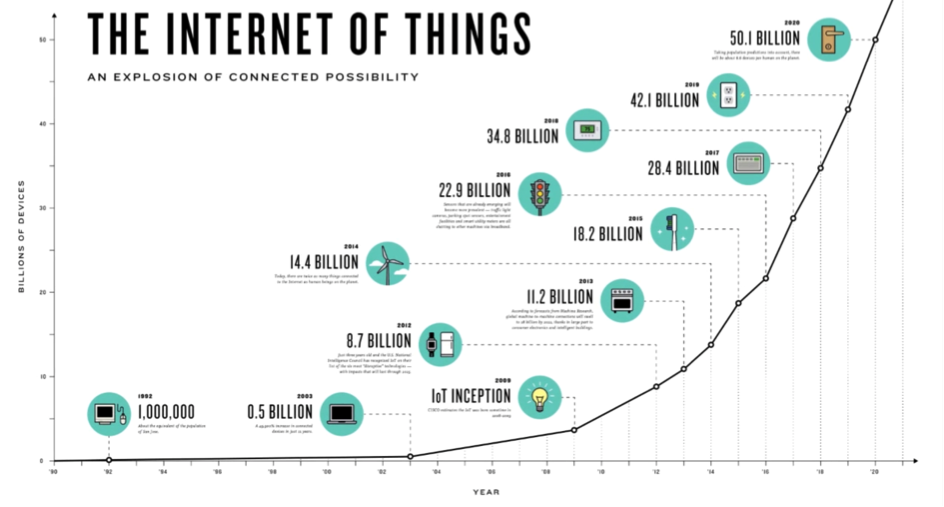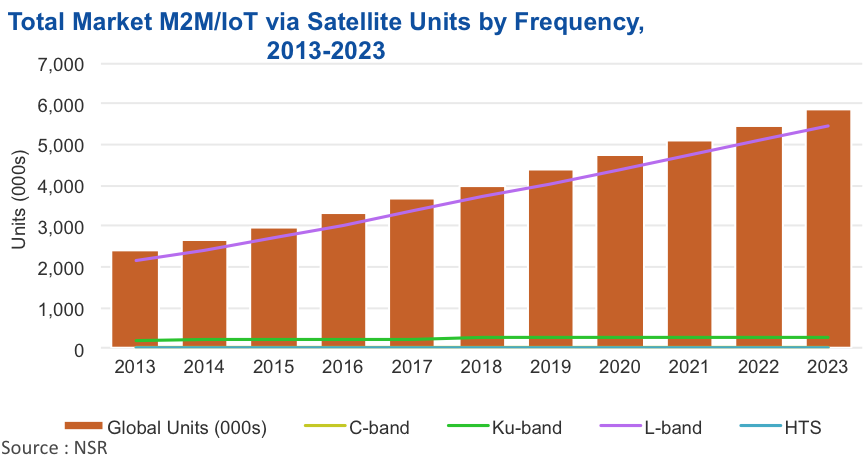Internet of Things: Prime Time for Satellite?
Feb 17th, 2015 by
Alan Crisp, NSR
The Internet of Things (IoT) continues to make headlines,
with enormous numbers of devices poised to go online in the
coming years. Huge predictions dominate, for example with Cisco
forecasting that by 2020, there will be an estimated 50 billion
Internet connected devices worldwide, including computers, smart
phones, tablets, as well as the traditional corporate M2M/IoT
and SCADA units. This is massive growth from the estimated
12 billion devices in 2013; but, can satellites grab a piece of
this ever growing pie?

Source: Cisco
In its recently released
M2M and IoT via Satellite, 5th Edition study, NSR
found that by 2023, there are estimated to be 5.8 million
satellite M2M and IoT connections globally. This is led by
L-band with over 93% of in-service terminals in 2023. Ku-band
comes a distant second with 5.2% of units, and C-band and HTS
remain, with less than 1% each, in use for niche markets – in
very specific applications and regions. L-band dominates
primarily due its lower cost terminals, and their smaller
physical size. The key question is: will lower cost L-band
terminals be enough to drive adoption in the consumer IoT
market?

The majority of upcoming consumer IoT applications
will be based on terrestrial technologies due to its lower cost
– both in terms of airtime and hardware. Nowhere is this more
visible than the recent funding for the up and coming
terrestrial M2M network Sigfox to the tune of $115 million,
which includes funding from satellite operator Eutelsat.
Sigfox promises to charge consumers as low as $1/month for
airtime on consumer IoT devices. Currently only rolled out in
France, Spain and the UK, the company aims to use this funding
to expand worldwide in Europe, Asia and the Americas.
Sustainable or not long-term, aggressive competition globally is
becoming the new norm in this space.
Nevertheless despite plentiful competition, research from NSR
finds the satellite consumer IoT market has potential,
although it is still finding its place. Currently a lack
of communications standards is limiting growth, with most
devices using existing communication methods of Wi-Fi and
Bluetooth (especially the low energy variant, Bluetooth LE).
With that said, the satellite dominant IoT market is
currently found in personal safety devices, such as
those currently served by SPOT on the GlobalStar network and
DeLorme InReach on the Iridium network. Due to the growth in
this sector, NSR expects additional safety and location products
to enter the market in the medium-term.
Developing a new product in this category in an already
expanding market means that many risks are already mitigated,
although companies looking to enter this market will
need to mindful of the free competition. Entrants must
compete with the not-for-profit Personal Location Beacon (PLB)
devices as part of the International Cospas-Sarsat Programme,
which has no monthly fee.
What this means is that additional value added
services need to be provided such as Duplex messaging,
telephone services, and even personal Internet hotspot
accessibility. Without these additional value added services as
well, ARPUs remain low, so additional add-on options and
flexibility will be needed to ensure future growth. One specific
opportunity NSR has identified here is for dual-mode
solutions, which can connect to both satellite and
cellular solutions, when in range. These features have been
successfully added to reduce the potential of price shock of
satellite access and to reduce costs to the end-customer.
Although this may be seen by some as a form of cannibalisation
of the satellite services, outcomes for some providers have
found the addition of cellular services to be additive to their
satellite businesses. Furthermore Eutelsat has demonstrated this
by contributing part of the $115 funding to Sigfox, aiming to
accelerate the development of the IoT market.
The other side of the business where satellite can grow is in
the consumer IoT market are backhaul-type solutions
where M2M/IoT data is aggregated via a VSAT network,
either in a consumer’s residence, or aggregated regionally.
Typically this is established in areas outside of a cellular
footprint. However in the long-term when there is expected to be
increased dependence on IoT technologies, there is also
certainly a role for VSAT networks in acting as a backup for
when terrestrial networks fail – especially in developing
regions where cellular networks can be significantly less
reliable or in mission critical applications such as in
healthcare.
Bottom Line
The consumer IoT via Satellite market is still
finding its place – but upcoming opportunities can be found,
with potential new entrants entering the personal safety device
market. Whilst the majority of consumer applications will be
based on cellular technologies, the vast growth of the number of
connected devices will mean that even a small sliver of devices
being connected to satellite networks will allow the consumer
IoT market to grow well into the future.

